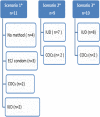Provider bias and family planning in Upper Egypt: a simulated client approach
- PMID: 37777657
- PMCID: PMC10542042
- DOI: 10.1186/s42506-023-00144-6
Provider bias and family planning in Upper Egypt: a simulated client approach
Abstract
Background: Provider bias is a main barrier that extensively violates the right of free family planning method choice. Egypt is one of the countries that shows skewness in its method mix. Provider bias and insufficiency of alternative methods are identified as potential factors underlying this phenomenon which contributes to high unmet needs and discontinuation rates. Provider bias may be influenced by cultural beliefs and societal trends and is usually overlooked as a possible cause of this skewed method mix. This study aims to explore the presence of provider bias in rural Upper Egypt and its potential causes, a community with conservative cultural beliefs and least contraceptive prevalence rates.
Methods: This is a qualitative study using the "simulated client's approach." The study was conducted in 16 villages in Assiut and Sohag governorates in Egypt. The simulated clients visited 30 clinics, 15 in each governorate, including primary healthcare units and private clinics. Three scenarios were used to explore the physicians-imposed restrictions for contraceptive use with different clients' eligibility criteria. Data was analyzed using the grounded theory methodology.
Results: Recommending a contraceptive method for the mystery clients was not based on informed choice. Most providers had method or client bias. Copper IUD was the most favorable contraceptive method recommended by providers, with negative attitude towards using hormonal contraception. Nulliparous and young clients were discouraged to use contraception before proving fertility or offered temporary methods as emergency contraception or condoms. Providers have shown misconceptions related to infertility-associated complications of contraceptive use, especially for the young and nulliparous women.
Conclusion: In this study, providers had a clear bias towards recommending IUD rather than all other contraceptive methods, which was hindered in some cases by the lack of insertion skills. Interventions to reduce provider bias should go beyond technical training. Moreover, training on reproductive rights should be a main component of routine training. Providers should regularly receive research results and be oriented toward recent medical eligibility criteria of contraceptive methods use. Moreover, the sociocultural beliefs of providers that may affect their practice should be explored and addressed.
Keywords: Bias; Egypt; Family planning; Provider.
© 2023. Egyptian Public Health Association.
Conflict of interest statement
The authors declare that they have no competing interests.
Figures

Similar articles
-
Bias in Contraceptive Provision to Young Women Among Private Health Care Providers in South West Nigeria.Int Perspect Sex Reprod Health. 2018 Mar 1;44(1):19-29. doi: 10.1363/44e5418. Int Perspect Sex Reprod Health. 2018. PMID: 30028307
-
Canadian Contraception Consensus (Part 2 of 4).J Obstet Gynaecol Can. 2015 Nov;37(11):1033-9. doi: 10.1016/s1701-2163(16)30054-8. J Obstet Gynaecol Can. 2015. PMID: 26629725 English, French.
-
Canadian Contraception Consensus (Part 1 of 4).J Obstet Gynaecol Can. 2015 Oct;37(10):936-42. doi: 10.1016/s1701-2163(16)30033-0. J Obstet Gynaecol Can. 2015. PMID: 26606712 English, French.
-
Attitudes of physicians providing family planning services in Egypt about recommending intrauterine device for family planning clients.Sex Reprod Healthc. 2017 Dec;14:64-68. doi: 10.1016/j.srhc.2017.09.004. Epub 2017 Sep 28. Sex Reprod Healthc. 2017. PMID: 29195636
-
Provider Bias in Family Planning Services: A Review of Its Meaning and Manifestations.Glob Health Sci Pract. 2019 Sep 26;7(3):371-385. doi: 10.9745/GHSP-D-19-00130. Print 2019 Sep. Glob Health Sci Pract. 2019. PMID: 31515240 Free PMC article. Review.
References
-
- Ayem D, SuhAtanga MB. Adaptable measures to increase uptake of family planning services in resource poor settings, Cameroon, Africa. Int J Curr Res Aca Rev. 2021;9(8): 1-6. 10.24941/ijcr.44176.11.2022.
-
- Kim YM, Kols A, Mucheke S. Informed choice and decision-making in family planning counseling in Kenya. Int Fam Plann Persp. 1998;24(1):4-11, 42. - PubMed
Grants and funding
LinkOut - more resources
Full Text Sources

